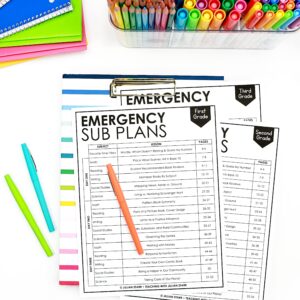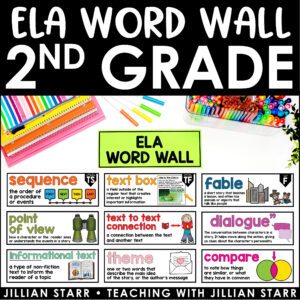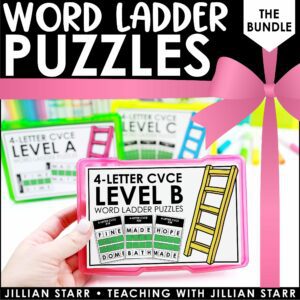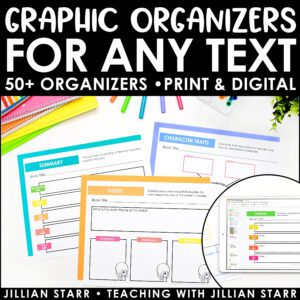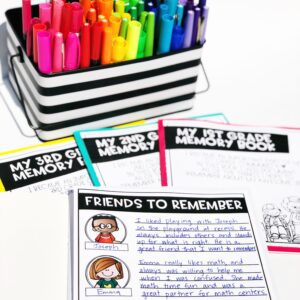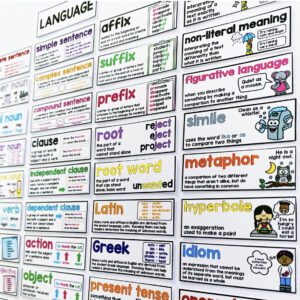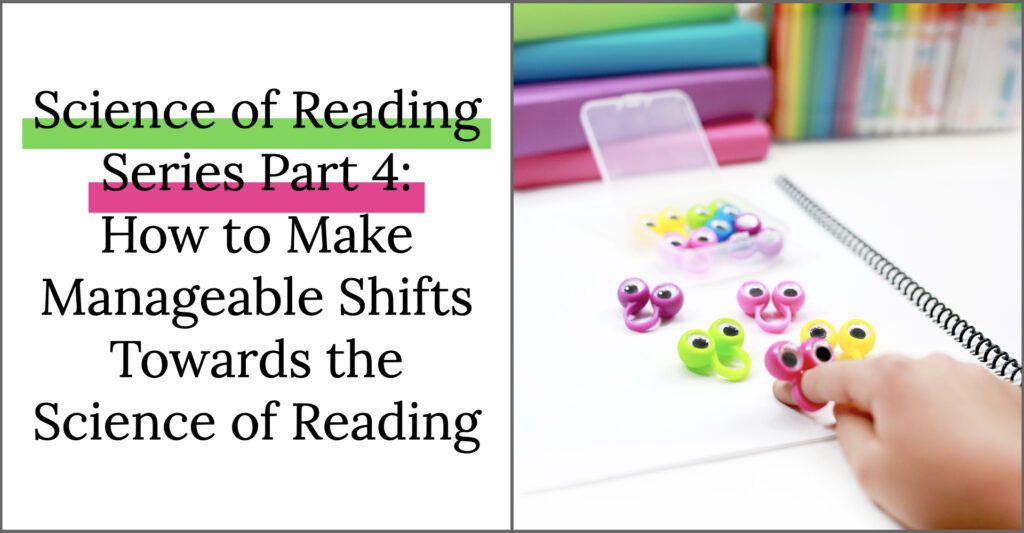
I’m so excited to be back for part four of our series on the Science of Reading! Today we’re going to dig deeper into how we can make adaptations in our own classrooms that will benefit all students. Especially if we’re teaching in a school or district that has not yet embraced the Science of Reading.
But first, did you miss part one, two, or three of this series? No problem! Just click those links to check them out and then meet us right back here.
Now, how do we bring more Science of Reading ideas into our classrooms? Or, what if the Science of Reading is not a priority in our district? Friend, DO NOT PANIC! There are so many places inside and outside of the literacy block where we can sneak in a little SoR (even if you’re required to use a scripted or non-Science of Reading-aligned curriculum!)
Rethinking Required Lessons
If you are required to follow a curriculum with daily, scripted lessons, get ready, because these next ideas are just for you and are guaranteed to help you make some meaningful shifts towards SoR-aligned instruction while still leaving space for you to fill your district requirements.
Finding Space in Whole Group Lessons
Feeling stuck with your whole group mini-lesson? I’ve got some quick, easy, and sneaky little ways you can tweak your teaching to bring in some of the most fundamental parts of the Science of Reading:
- Keep it brief! Shorten the part of your mini-lesson that focuses on the three cueing skills. Mention them briefly so that your students have heard them as strategies, but do not focus your time here. Instead…
- Elaborate on PHONICS! Keep these parts of the mini-lesson center stage. Highlight specific phonics skills by providing lots of examples, and give your students plenty of opportunities to practice these skills and strategies. This is where you want most of your time spent.
- Bulk it up with vocabulary! Expand the parts of the mini-lesson that focus on vocabulary and background knowledge. Often, our curricula comes with amazing non-fiction anchor texts. Capitalize on these engaging texts by highlighting skills that support the development of vocabulary and background knowledge. Bonus: if your curriculum does not include anchor texts, head to your classroom library (or even better, your school librarian!) to find non-fiction texts that will build your students’ vocabulary bank.
- Pull as much as you can into your science, social studies, or SEL time. I’m talking read alouds, vocabulary, anchor charts, anything goes! These skills can be taught and practiced outside of the literacy block. Seeing, hearing, and discussing this information in multiple parts of the day will reinforce literacy skills.
Small Changes in Small Group Time
At this point in the series, you know the importance of decodable texts in Science of Reading-aligned instruction. Small group lessons are the place to prioritize decodable books. By centering our lessons around a text our students can quickly and accurately decode, we provide ample opportunities to build fluency skills and solidify student understanding of the phonetic concepts from our whole group lessons. A big teacher win in my book!
Rethinking the Workshop Model & Independent Reading
If you are required to use a workshop model, it can be easy to feel boxed in by the structure it demands. You may even find yourself worrying about your students’ attention, stamina, and progress during independent reading time. I’ve been there, I hear you, and I’ve got great news: with a few small tweaks along the way, you can bring Science of Reading principles straight into your workshop block.
Partner Reading
Building partner reading into your independent reading block is a powerful way to engage students, especially some of those hesitant readers who can be so hard to reach! It always feels more fun to do a non-preferred task with a friend, and partner reading gives our students just that, while also providing time to build fluency and discuss books. This can be added to the middle of independent reading time, or saved for the last ten minutes of the block.
Book Stacks
We all know this important fact: kids love choice. In fact, they thrive on it. By offering choice, we empower students and offer them ownership over their learning in a meaningful way. Sound good to you? Book stacks are just the ticket to spice up your independent reading time.
If you’re not familiar with the book stacks, the idea is that students gather the books they’d like to focus on during independent reading and put them in a specific order, with a specific goal or mood in mind. Feeling up for a challenge? Kids can put their hardest books first. Feeling like an old favorite? Students can line up books from small group first, and add newer texts later in the stack. The idea here is that our readers will spend less time shuffling around in their book boxes or deciding which book to read next.
A Note About Book Stacks
As with many strategies we use in our classroom, this one comes with a caveat: If you have a student that is struggling to read independently successfully, or a student that has challenges with attention, focus, or executive functioning, a stack of books staring them down might make them want to do anything but read! Or even the act of creating a stack might send some kids over the edge. Luckily, there are ways that we can modify the book stack and independent reading block to make sure we are supporting all learners:
- Students can choose one book to start reading. Then, they can take a two-minute break in our classroom safe space or get a drink from their water bottle. This brief movement break can provide just the reset they need to continue on.
- Teachers (or even better, a paraprofessional or push-in support staff if that’s available to you) can check in with students privately about goals and strategies for this reading time. Explicitly creating a manageable goal can make all the difference!
- Some students might benefit from alternating between reading a text and then listening to a chapter of an audiobook.
- Some students might keep their book box near the teacher table and swap out books one at a time to create a movement break in between books.
Book Breaks
What’s a book break you ask? Think of it as a mini-vacation from books we can offer to students to help them maintain engagement and momentum during independent reading time. We can incorporate a Science of Reading mindset by thinking creatively about the book breaks we offer students. Creativity is key here! Maybe it’s a poem or a shared reading passage from an anchor text. This quick and familiar one-pager can be added to the book stack for students to read in between books.
Bonus tip: Do you also use poetry journals in your classroom? Add these to your students’ book stacks! Students can pull out a familiar poem with a phonics pattern that they have practiced. Because we introduce and practice our phonics poems one week and one skill at a time, I can rest assured that my students can decode the poems and are getting a meaningful opportunity to practice fluency.
Using the Magic of Literacy Centers during Independent Reading
Are literacy centers a part of your reading block? If so, this is a perfect way to work in some small but meaningful shifts that support the main ideas behind the Science of Reading.
Word Sorts
Does your school or district use a word sorts or spelling curriculum? Here is a perfect way to work some SoR concepts into your independent reading routine!
A few years ago we began gluing down our word sort words as one final review before we moved on to the next list. Now my students’ word work notebooks include their practice from the word work menu as well as all the word sorts they have done up until that point in the year. My students LOVE reading those completed word sorts! It’s great practice with phonics skills that they have mastered or are currently practicing. Adding their Word Work notebook to their book stack is a great tool to keep independent reading exciting and offer an additional opportunity for phonics review.
Reading Journals
Reading journals are one of my tried and true favorites. We can’t live without them! There are so many different ways we can use reading journals as tools to support the work students are doing in both small group and independent reading time. Even better: writing about reading has so many benefits! For example:
- Understanding what our students are thinking about their reading
- Making connections
- Practicing phonics and comprehension skills
- Practicing writing skills
How can we build time to write in Reading Journals during independent reading time? Some practices that always get my students excited are:
- Using reading journals as a literacy center that all students go to
- Offering students their reading journal as an option to include in their book stack
- Beginning work in our reading journals during small groups, to be finished during the center block or during one of those small weird chunks of time we all have in our schedules!
- An activity for early finishers
Reading Logs
Some of the reading curricula that we are expected to use in our classrooms will require the use of reading logs. If you have any wiggle room with this practice, consider the intentions and goals of using a reading log. Different types of reading logs can work well depending on our students’ personalities, feelings towards reading, and motivations.
A small group lesson is a great place to talk to students about reading logs, especially when we consider using heterogeneous groupings. We can meet with students that have similar reading tendencies and motivations, not necessarily at the same reading level or working on the same skills. Adding an entry to a reading log can be a great way to switch gears during that independent reading block and can help kids reset and get ready to read their next book.
Bonus: Tracking reading with a log can be an incredibly motivating tool for some students. Have readers like this in your classroom? Pair them up with like-minded readers to track the texts they’ve read and talk about them!
How to Win with Sticky Notes
I know, I know: there are a lot of big feelings around sticky notes. Maybe you love them. Or perhaps, the sight of them all over your classroom is just too much. Maybe you try following the lessons in your reading curriculum and feel like students are really missing what they are “supposed” to be doing with sticky notes. Whether you love ’em or hate ’em: I’ve got good news today. If you are expected to have students jot down things on sticky notes during reading time, there are ways you can make this practice more productive and meaningful for your students and incorporate SoR ideas in the process!
Sticky Notes to Reinforce Phonics Skills
Instead of asking students that struggle with reading and writing to write an elaborate connection or question on a sticky note (a task that can feel completely insurmountable to many students!), we can reinforce phonics skills we are practicing in our whole class and small group lessons. For example:
- Encourage students to jot down flash words and heart words they recognize in their reading
- Ask students to jot down words from their reading that match the phonics pattern you’re currently working on
- Include those sticky notes in a notebook of “words I can read” or “sight words” or “phonics pattern words.” Students can read this notebook as part of their book stack or take it home and share their progress with caregivers.
Sticky Notes to Support Reading Strategies
Sometimes it’s too much to ask our students to hold on to an abstract concept from the mini-lesson and come back with a sticky note as proof that they made that same connection in one of their books. Some skills are very specific to a certain type or level of the book. Our students may not have advanced character development in an early decodable book. Other times, our students may be reading a nonfiction book, so they won’t be able to “jot down” the plot of the book. Is there another way that we can assess if our students are applying these reading strategies to their reading besides a sticky note? You bet! Some ideas:
- We can practice these skills with a read-aloud book or small group book. This way, we can choose a book with the necessary content to apply and practice a given skill. Students will have the common experience of hearing or reading the same book or passage. Then they can practice the corresponding skill through discussion with their teachers and peers.
- There are opportunities for sticky notes when reading nonfiction and jotting down important facts. This is generally a time when all students reading a nonfiction book at their given level. Most students could likely find relevant information to write down.
By looking at our current literacy practices with the principles of the Science of Reading in mind, we can begin to think a little differently. A little tweak here and there can make a HUGE difference in our students’ literacy experiences!
I hope you’ve found a few shifts that you can start to make in your classrooms right now. Remember, this is big stuff and change doesn’t happen overnight. As your virtual teammate, I’m on this journey with you. I’d love to hear about what questions you have and where you’re finding space to make these shifts. Share it with us in the comments!

